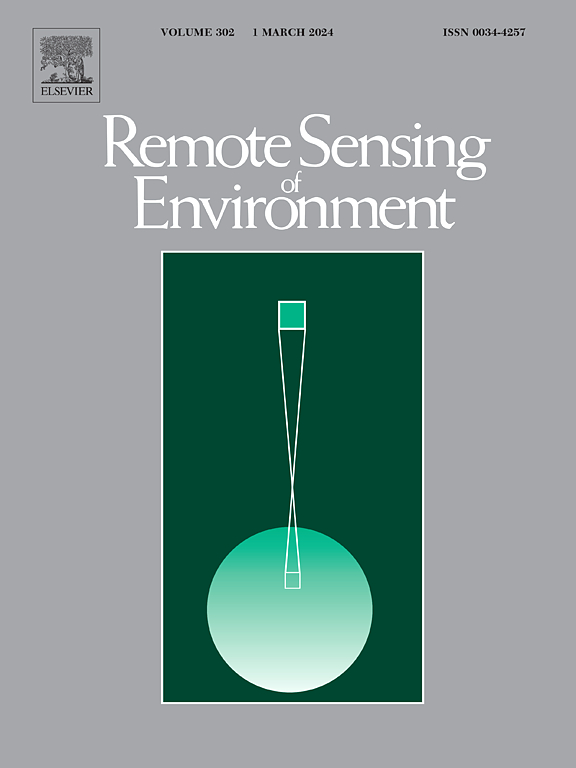AVHRR记录和一种新的自回归燃烧面积检测算法捕获了1983 - 2020年环周森林燃烧面积的大幅增加
IF 11.1
1区 地球科学
Q1 ENVIRONMENTAL SCIENCES
引用次数: 0
摘要
野火通过催化养分循环和森林演替来维持北方森林的健康。然而,由于气候变暖导致的年燃烧面积增加可能会促进森林损失和土壤碳释放,因此对周边燃烧面积的监测具有重要意义。我们的目标是利用先进甚高分辨率辐射计(AVHRR)数据表征1983 - 2020年环周燃烧面积的区域变化特征,并确定燃烧面积增加具有显著趋势的生态区域。我们通过开发和应用一种新的基于AVHRR和MODIS MOD09CMGv061时间序列自回归分析的烧伤面积映射算法来实现这一目标。我们的算法运行良好,得到的烧伤面积总量与MODIS MCD64A1v61烧伤面积产品在两者可用的年份(2001 - 2020)相似;然而,我们的AVHRR烧伤面积数据集的优势在于它可以追溯到1983年。基于得到的烧伤面积图,我们评估了周边烧伤面积的变化,并测试了显著的趋势。净变化是显著的:20世纪80年代仅5.37%的环周生物群系被烧毁,而2010年代则增加了8.22%,增加了2.85%(= 8.22 - 5.37%),相当于燃烧面积的比例增加了0.53(= 2.85/5.37)。在一个生态区,Muskwa奴隶湖森林,从20世纪80年代到21世纪10年代,被烧毁的面积增加了两倍多,在三个生态区(加拿大北部盾状针叶林,育空内陆干旱森林和东北西伯利亚针叶林),被烧毁的面积增加了两倍多。此外,尽管燃烧面积的年际变化通常很高,但我们发现23个北方森林生态区中有7个地区的燃烧面积有统计学上显著的增加趋势,对应于19.6%的北方森林(35%的北美和11%的欧亚北方森林),而只有一个生态区(加拿大东部盾状针叶林)有减少趋势。通过分析长期的AVHRR记录,我们能够捕捉到比较短的MODIS记录更大的燃烧面积增长,从而使我们能够量化这些增长的广泛程度和实质性。通过分析生态区域,我们发现西伯利亚东北部、加拿大西北部和阿拉斯加北方森林的燃烧面积增加最多。这些燃烧面积的增加可能对未来欧亚和北美北方森林的森林持久性和碳储量产生影响。本文章由计算机程序翻译,如有差异,请以英文原文为准。
Substantial increases in burned area in circumboreal forests from 1983 to 2020 captured by the AVHRR record and a new autoregressive burned area detection algorithm
Wildfire maintains boreal forest health by catalyzing nutrient cycling and forest succession. However, increased annual burned area due to climate warming may facilitate forest loss and soil carbon release, which makes it important to monitor circumboreal burned area. Our goal was to characterize regional changes in circumboreal burned area from 1983 to 2020 using Advanced Very High Resolution Radiometer (AVHRR) data, and to identify the ecoregions where increases in burned area represent significant trends. We accomplished this by developing and applying a new burned area mapping algorithm that is based on an autoregressive analysis of the AVHRR and MODIS MOD09CMGv061 time series. Our algorithm worked well, and resulting burned area totals were similar to those of the MODIS MCD64A1v61 burned area product for years where both were available (2001−2020); however, the advantage of our AVHRR burned area dataset is that it extends back to 1983. Based on the resulting burned area maps, we evaluated circumboreal burned area changes and tested for significant trends. Net changes were substantial: while only 5.37 % of the circumboreal biome burned in the 1980s, 8.22 % did during the 2010s, an increase of 2.85 % (= 8.22–5.37 %) that corresponds to a proportional increase in area burned of 0.53 (= 2.85/5.37). In one ecoregion, Muskwa Slave Lake Forests, burned area more than quadrupled from the 1980s to the 2010s, and in three it more than tripled (Northern Canadian Shield Taiga, Yukon Interior Dry Forests, and Northeast Siberian Taiga). Furthermore, despite interannual variability in burned area typically being high, we found statistically significant increasing trends in burned area in seven of the twenty-three boreal ecoregions, corresponding to 19.6 % of boreal forests (35 % of North American and 11 % of Eurasian boreal forests), while only one ecoregion (Eastern Canadian Shield Taiga) had a decreasing trend. By analyzing the long-term AVHRR record, we were able to capture much larger increases in burned area than from the shorter MODIS record, allowing us to quantify how widespread and substantial these increases have been. By analyzing ecoregions, we found that north-eastern Siberian, north-western Canadian, and Alaskan boreal forests have experienced the most increases in burned area. These increases in burned area may have implications for future forest persistence and carbon storage within Eurasian and North American boreal forests.
求助全文
通过发布文献求助,成功后即可免费获取论文全文。
去求助
来源期刊

Remote Sensing of Environment
环境科学-成像科学与照相技术
CiteScore
25.10
自引率
8.90%
发文量
455
审稿时长
53 days
期刊介绍:
Remote Sensing of Environment (RSE) serves the Earth observation community by disseminating results on the theory, science, applications, and technology that contribute to advancing the field of remote sensing. With a thoroughly interdisciplinary approach, RSE encompasses terrestrial, oceanic, and atmospheric sensing.
The journal emphasizes biophysical and quantitative approaches to remote sensing at local to global scales, covering a diverse range of applications and techniques.
RSE serves as a vital platform for the exchange of knowledge and advancements in the dynamic field of remote sensing.
 求助内容:
求助内容: 应助结果提醒方式:
应助结果提醒方式:


